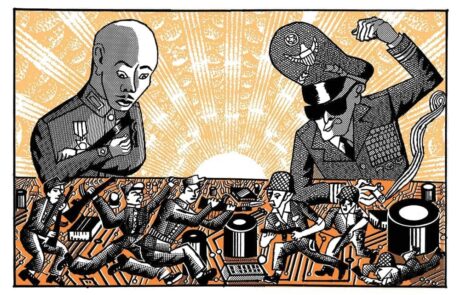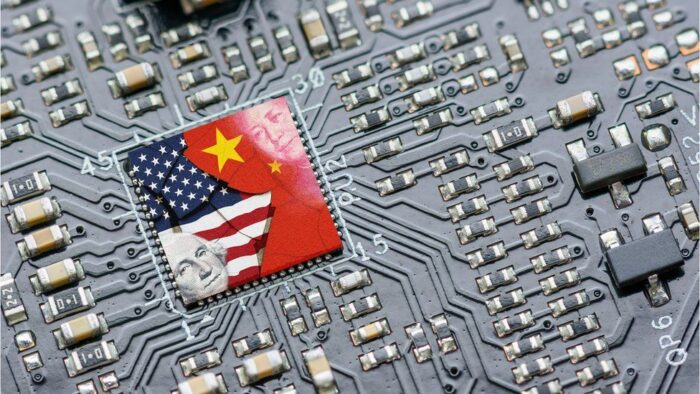Published in Mekong Review February 2023
The title of Chris Miller’s meticulously researched and super-timely book can be taken two different ways. It could refer to the competitive struggle between the corporate giants of the semiconductor industry. It could also refer to the increasingly crucial role of semiconductors in actual warfare. As it happens, in 2022 we were given a real-time demonstration of the latter.
The war in the Ukraine has proven, much to the shock of Vladimir Putin, that America’s new generation of high-tech weaponry comfortably outmatches Russia’s superiority in troop numbers, tanks and twentieth century vintage missiles. Author Miller could not have foreseen these developments but would not have been surprised. Indeed, he gives a fascinating account of the Soviet Union’s ill-fated attempt to create a semiconductor industry in a specially built town called Zelenograd.
Soviet scientists were top-notch, as were their industrial spies, and no less a person than President Nikita Khrushchev gave the project his personal stamp of approval. Nonetheless, it was doomed to stagnation and failure because the Soviets had no non-military market for semiconductors. Meanwhile, in the United States, the percentage of semiconductor production destined for military use was declining rapidly as huge new markets for calculators, other electronic gizmos and eventually personal computers appeared.
In 1965, Gordon Moore of Fairchild Semiconductor and later Intel predicted that the computer power on each chip would double every few years. “Moore’s Law”, which Miller calls the greatest ever technological prediction, enabled this cascade of change. No command economy could hope to live with it. Who won the Cold War? The author’s answer is Silicon Valley. To rub in the message, he notes that in the 1990s the Russian semiconductor industry was reduced to producing chips for McDonalds’ Happy Meal toys.
That may sound like a ringing endorsement of American free market capitalism, but the tale the author tells is a great deal more complex. Government was there right from the start. Texas Instruments’ first major contract for semiconductors was for nuclear missiles, and specialist personnel worked closely with the U.S. Air Force to develop laser-guided bombs for the Vietnam war.
DARPA, the Pentagon’s “Defense Advanced Research Projects Agency”, was and is deeply involved in the semiconductor industry. According to Miller, “helping companies and professors keep Moore’s Law alive, DARPA reasoned, was crucial to America’s military edge… Today every chip company uses tools from each of three chip design companies that were founded and built by alumni of these DARPA- and SRC- [Semiconductor Research Corporation] funded programs.”

When things were going well, as was the case in the sixties and seventies, Silicon Valley wanted the government to leave it alone. When the going got tough, as it did in the 1980s when Japanese semiconductor producers became dominant, they howled for protectionist measures against “unfair competition” and got it. Japan was nominally an ally, but in the paranoic atmosphere of the era – as reflected in Michael Crichton’s book and film “Rising Sun” – it was treated as a challenger and rival.
Politics was even more instrumental in the creation of TSMC (Taiwan Semiconductor Company), which now dominates the global manufacture of semiconductors. The Taiwanese government provided 48% of the start-up capital and another 24.5% was raised from wealthy Taiwanese who were “asked” to invest. One hold-out was called in by the prime minister and told that failure to invest would be a mistake. He got the message and fell into line. The rest of the capital went to the Dutch company Philips in exchange for intellectual property. In a master stroke, government officials recruited Morris Chang, a veteran of Texas Instruments who had never lived in Taiwan, to head up the company. Chang’s contacts in the industry enabled him to recruit many top employees who had worked in Silicon Valley.
In Miller’s words, “from day one, TSMC was not really a private business: it was a project of the Taiwanese state.” The government sponsored semiconductor manufacture for a variety of reasons, including the possibility of ascending the value chain and becoming a richer country. In that, it has triumphally succeeded with Taiwan’s GDP per head now higher than that of Japan and South Korea in purchasing parity terms. But the project had another more important, indeed existential goal.
In the early 1970s, President Nixon and his Secretary of State Henry Kissinger engineered a rapprochement with Mao Zedong’s People’s Republic of China, recognizing it as the legitimate representative of China and severing relations with Taiwan, which was expelled from the United Nations. There was always a possibility that Taiwan might disappear entirely, either through a successful takeover by the Chinese military or as part of another grand bargain between the two superpowers. Unless, that is, the small island state with a population one seventy fifth of mainland China’s could somehow make itself indispensable.
That is exactly what it has done. Today, TSMC manufactures nearly all the world’s advanced processor chips, including all Apple’s i-Phone processors. Miller estimates that altogether chips from Taiwan provide 37% of the world’s new computing power. A lengthy interruption to that supply would deal a body blow to the world economy that would make the economic fallout of the Ukraine war seem like a hiccup.
The world consumes a trillion chips a year. They are embedded in nearly every complex device we use. They are as strategically important as oil and gas, but unlike oil and gas there is no substitute technology on the horizon. Worse, while oil and gas can be sourced from many parts of the globe, nearly all advanced semiconductors are manufactured in East Asia, the likely flashpoint of any military conflict between China and the United States.
Such global vulnerability is testimony to the success of Taiwan’s national strategy. No wonder that Taiwan’s ex-President Tsai Ing-wen described the island’s chip industry as “a silicon shield that allows Taiwan to protect itself”. It is also what the United States wanted. Miller’s take: “Washington’s foreign policy strategists embraced complex semiconductor supply chains as a tool to bind Asia to an American-led world”.
Last year, TSMC set up a chip-manufacturing plant in southern Japan, and American President Joe Biden recently visited TSMC’s Arizona plant, expected to start operating in 2024, which is touted as the largest ever foreign indirect investment into the United States. In reality, though, these plants will produce a tiny fraction of TSMC’s total output of chips, and not the most advanced type. It is in Taiwan’s interest to keep as much of its capability as possible onshore. If the U.S. wishes to maintain its position in East Asia, the epicenter of global growth, it cannot afford to lose Taiwan. For both countries, the status quo works, perilous as it may be.
What we have here is a high-tech version of the Cold War balance of forces known as Mutually Assured Destruction or, for short, MAD. Both the Soviet Union and the United States knew that their enemy had the ability to wreak terrible destruction via their nuclear arsenals and therefore desisted from acting. In today’s world, a Chinese move on Taiwan followed by an American response would not only crash the world economy but do permanent damage to the chip industry.
That includes China’s own chip industry which is a long way from securing independence from the US-dominated, but multi-national semiconductor ecosystem. China spends more money importing semiconductors than it does on oil. As Miller states, “in nearly every step of the process of producing semiconductors, China is staggeringly dependent on foreign technology, almost all of which is controlled by China’s geopolitical rivals – Taiwan, Japan, South Korea or the United States.”
Indeed, the Dutch company ASML, a spin-out from Philips, has a 100% market share in EUV (“extreme ultraviolet”) photolithography equipment, essential for etching tiny transistors more than half the size of a coronavirus on silicon wafers. Without that equipment, the most advanced semiconductors, such as those in an iPhone 12, could not be made. Currently, there is a political dispute between the Dutch government and the Biden administration as to whether ASML should sell its latest machines to China. In the case of a confrontation over Taiwan, sales of all such high-tech equipment would surely come to a complete stop.
China is not the Soviet Union. It has a far larger consumer market and many more talented entrepreneurs, scientists, and industrial spies. Over time, it may well close the gap in semiconductor capability. In recognition of that risk, the U.S. has adopted a much tougher approach, effectively destroying Huawei as a global player and using wide-ranging powers to restrict the sale and transfer of leading edge equipment and knowhow to China.
U.S. National Security Advisor Jake Sullivan explained why in a speech last September: “we previously maintained a ‘sliding scale’ approach that said we need to stay only a couple of generations ahead. That is not the strategic environment we are in today. Given the foundational nature of certain technologies, such as advanced logic and memory chips, we must maintain as large of a lead as possible.”
For the time being, the precarious balance of Mutually Assured Destruction remains in place. As in the Cold War, realistic fears of what could go wrong have become the best deterrent. Meanwhile the tech giants of the U.S., Taiwan, Japan and South Korea continue to pour out semiconductors in their billions and trillions. There is one thing that both sides agree on. Computer chips are no longer, if they ever were, products to be bought and sold like potato chips. They are inextricably bound up with geopolitics and the future of East Asia.
Chris Miller deserves our thanks for bringing this difficult and multifaced subject to life, explaining the technology with great lucidity and introducing us to the remarkable human beings who shaped today’s semiconductor industry.
